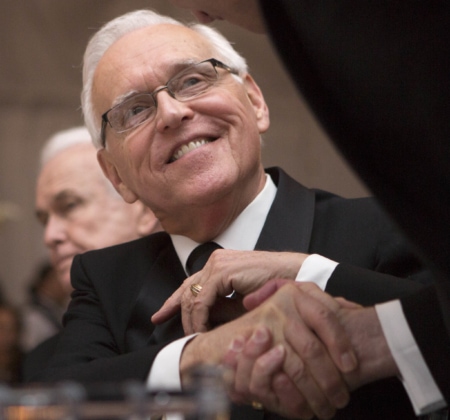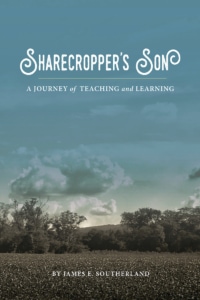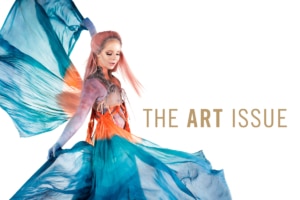One Ballsy Burd
The mild-mannered former president of Brenau University strikes no one at first blush as a shoot-first-ask-questions-later gunslinger. However, when he set out to corral an extraordinary art collection for the school, he relentlessly took no prisoners.
In about his second year, Brenau President John S. Burd initiated development of the Permanent Art Collection at Brenau – one of the finest assemblages of paintings, drawings, photography, sculpture and other artwork on any campus in the South, especially one as small as Brenau. Brenau had a strong liberal arts reputation and Jack wondered why, then, Brenau paid such comparatively little attention to art. He decided brazenly to do something about it. He placed an ad in The New York Times stating candidly that an exclusive liberal arts institution was soliciting art donors, artists and art collectors. [Although that may have seemed a bit desperate, he] received numerous replies.
However, the big breakthrough occurred following an alumnae committee meeting when Mary Foote Paris, whose father had been a Brenau faculty member before World War II, told the president that two aunts of the well-known contemporary artist Jasper Johns had graduated from Brenau College. Burd seized on that information immediately. It was the kind of opening he was searching for.
Jack Burd certainly knew who Jasper Johns was. Johns was extremely popular in the art world in the 1950s and 1960s, and some of the work he produced in that era has set all kinds of sales records, including $80 million that private collectors Anne and Kenneth Griffin paid the movie and music producer David Geffen for a 1959 Johns painting titled “False Start,” making it the most expensive painting by a living artist.
Born in Augusta, Georgia, Johns spent much of his early life in South Carolina. According to Burd, after his parents’ marriage failed, Johns lived with his mother for a while and in Columbia with his paternal grandparents, who would not allow the boy to be raised in a broken home. He also lived for several years with his aunt Gladys Johns in Murray, about 22 miles from Columbia. Gladys and her sister, Eunice Johns, both attended Brenau College in the 1920s.
Mary Paris’ family lived on Prior Street, which runs through the Brenau campus. She was the daughter of Dr. Henry Simmons. She told Burd that one of Johns’ aunts had appendicitis while she was a Brenau student and stayed in the Simmons’ home during her convalescence.
Burd began making calls right away but had extreme difficulty connecting with the artist. His telephone messages for Johns went unanswered. Innocent of art world protocol and of the artist’s notorious aloofness, Burd wrote Johns a letter, mentioning the aunts’ connection to Brenau and asking the artist to donate a work of art to the college to honor his aunts or to do a show of his work at Brenau to help raise money for improving the collection of the college arts program.
“I got a curt note back saying, ‘I don’t do that,’” Burd recalled in a 2010 interview with the art critic Catherine Fox for an article in “Brenau Window.” (Editor’s note: the Fall 2010 issue of Brenau Window is available for download as a PDF.) Then, I called Jasper again. His secretary told me to talk to Jasper’s agent, Leo Castelli.”
Burd dutifully called Castelli and made what he thought was a perfunctory, routine appointment to visit Castelli at his gallery in New York City.
“When I went to the art department and told the faculty what I had done, they swooned,” he said. “I had no idea who Leo Castelli was other than Jasper’s sales agent. They set me straight immediately and loaded me up with a ton of information, including an earlier book about Castelli.” By the time he met with Castelli that first time, the art department had thoroughly schooled him on the dealer’s role, prominence and influence in the art world.
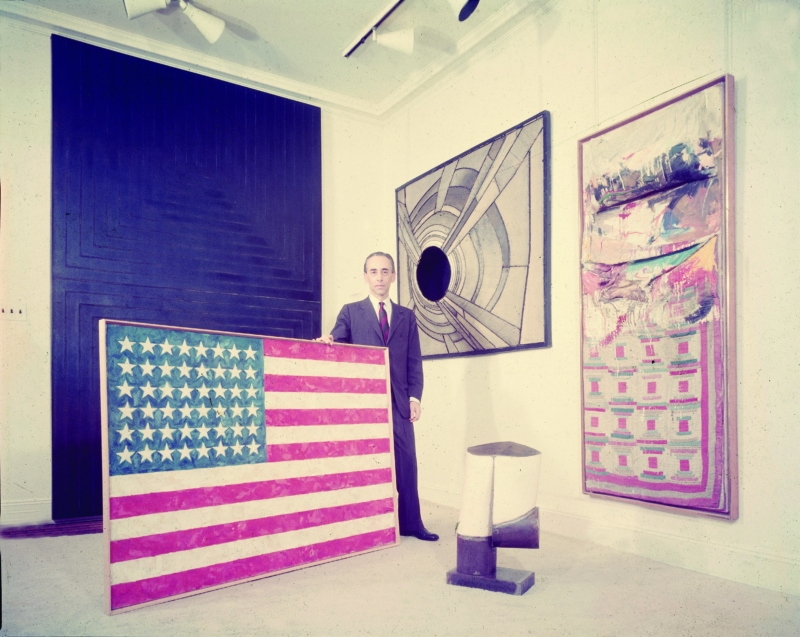
The Brenau president very quickly learned that Castelli, who died in 1999, played an important role in shifting the art world’s center of gravity from Europe to the United States and in making America more receptive to contemporary art. As Annie Cohen-Solal put it in her 2010 biography, Leo & His Circle: The Life of Leo Castelli, “No one [has] done more than Castelli himself to introduce major new currents in the flow of art history, or to win for the American artist great stature at home and abroad.” Possessing an eye for spotting emerging talent, a heart for nurturing those artists and a nose for promoting them, Castelli jump-started the careers of some of the most important artists in the last half of the 20th century, including Jasper Johns.
After two initial visits to Castelli’s SoHo gallery, Burd made a third trip, accompanied by trustee M. Douglas Ivester, a Gainesville native who was the Coca-Cola Company CEO. Ivester made available a corporate jet for the trip. Bemused by Burd’s moxie in the visits, the dealer agreed to organize a show for Brenau. (A retrospective exhibition of Johns’ prints from Castelli’s private collection opened in March 1991 as the debut show in the newly renovated Simmons Visual Arts Center, the cornerstone of Brenau Galleries.) During that third visit, however, Burd also took another bold step, asking Castelli to join the Brenau board. “He was delighted, but he made it very clear to me that he didn’t have any money. He said, ‘I have art connections, and I will help you.’”
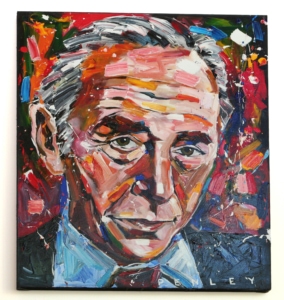
Castelli joined the Board of Trustees in 1989 and kept his word to Burd. The permanent collection now numbers more than 6,500 pieces, a number that grows each year, thanks in significant measure to the continuously expanding network of relationships for which Castelli was the nucleus. The Castelli connection led to the college’s exhibiting works of Lichtenstein, Rosenquist, Warhol, Rauschenberg and others. This in turn prompted many significant donations and acquisitions of work by those and many other artists, not to mention appearances by great artists and arts influencers. For example, in 1992, Rauschenberg came to campus, beginning relationships with the artist and his circle that continues today long after Rauschenberg’s death, resulting in Brenau’s holding in its permanent collection what some have suggested is the largest number of that artist’s work other than those held by the Rauschenberg estate and foundation. The college through Castelli had an entré into the New York art world, which continues to pay handsome dividends.
One of my students who emerged from the influences of “the Castelli era” on campus was the artist Sarah Lamb Larned, a 1993 Women’s College graduate who has become an excellent, nationally acclaimed still-life painter. Sarah probably came to us as a traditionalist – the fourth generation in her family to study at the school, following her mother, Glee Boyle Lamb, class of 1967; her grandmother, Sarah Byers Boyle, 1943; and great-grandmother, Mildred Pyles Byers, class of 1918. I am reasonably confident that somebody in the Brenau administration already has their eye on Sarah’s daughter, Sadie, to get a fifth generation enrolled!
When Sarah was about 12, she recalls seeing the “three generations of Wyeth” exhibition at a Washington gallery. That hooked her on the realism of the painter Andrew Wyeth, his father N.C. and son Jamie, and after establishing herself as an up-and-coming young artist, she and her husband, portrait artist David Larned, settled in Chadds Ford – the Wyeth “Brandywine school heartland” – shortly after they were married. In 2006 they moved into a beautifully restored 300-year-old farmhouse once owned by the actor Claude Rains, in a setting that could easily inspire countless more generations of budding Wyeths with its vista of rolling pastures, a spring-fed pond, ruins of an ancient barn and specimen trees. The family now splits time between their homes in Houston, Texas, and Pennsylvania. (Editor’s note: Read more about Sarah Lamb Larned in the article “At Home With Tradition” in the PDF of the Winter 2008 issue Brenau Window.)
Part of Burd’s arts improvement strategy was to develop places to hold shows and exhibitions for world-class artists. Thus, the university created three galleries on the historic campus as well as “living galleries” that have works hanging on appropriate wall space in virtually every facility that has Brenau’s name on the door. Until recently, when the collection got so big that this process put a serious strain on Brenau Galleries personnel, if there were a set of Walker Evans photographs, a signed Andy Warhol poster or a group of small Alexander Calder prints in the permanent collection that were not on exhibition somewhere else, you could call the Brenau Galleries staff and they would hang the pieces you selected in your office.
When the new Brenau Galleries opened for business, Castelli kept his word again and helped Burd and the galleries staff put on a show featuring Jasper Johns’ prints from Castelli’s personal collection. One of these, subsequently donated to the university, is the artist’s proof of his American Center Paris, 1994 lithograph, which features a childhood photograph of Johns’ family, including his Brenau aunts, Eunice and Gladys.
Burd, still persistent about establishing a relationship with Johns, and still a little, shall we say, naive in protocols for dealing with world-famous artists, told Johns, with a charming innocence and temerity that only he could get away with, that he really did not understand the piece and asked Johns to “explain it.” Perhaps in his own tribute to Burd’s chutzpah, the cranky artist dashed off a full-size tissue paper overlay of the huge print, diagrammed the piece and sent it to Burd. It was the kind of thing, Castelli told Burd, that Johns never did for anyone. Furthermore, some of our art experts gamely speculate that the one-of-as-kind sketch may even be worth more than the print.
When Brenau Galleries celebrated its 25th anniversary in 2016, they did so with another show of Jasper Johns’ prints, curated with the help of Johns’ longtime printmaker Bill Goldston from Oyster Bay, New York. Although the then-88-year-old Johns did not attend the opening of the show, Goldston did, and he brought with him to the Brenau campus his wife, the world-renown landscape artist Riccarda de Eccher.
The Permanent Art Collection was a tremendous legacy of the Burd presidency. His foresight and hard work in cultivating a relationship with Leo Castelli, brought about through his initial contact with Jasper Johns, has been extremely beneficial. One of the collateral benefits is that it helped Brenau attract the attention of the High Museum of Art in Atlanta, which resulted in the two institutions’ negotiating an academic partnership that has existed since 2010.
The relationship Dr. Burd had initiated with Leo Castelli helped the school gain acclaim as a center for art. Beginning with that 1991 show, “Jasper Johns’ Print Retrospective from the Leo Castelli Collection,” we followed in fall 1992 with “Robert Rauschenberg: A Print Survey in Themes, 1952-1992,” courtesy of the Leo Castelli Gallery.
Rauschenberg came to the exhibition and was a huge hit. The well-known and controversial artist, dressed in all white, made quite an impression on those who came to see his works. I enjoyed chatting briefly with him at the reception. Following the reception, an art historian lectured about Rauschenberg’s work.
In the middle of the lecture, I saw the famous artist walking down the hallway outside the auditorium. What an odd sight, I thought. I wondered whether Rauschenberg had agreed with the critic’s assessment, had been offended by it, or what. However, Rauschenberg had consumed a great deal of wine and in his impaired state probably did not care. I later learned that Jack Burd saw Rauschenberg outside, standing by the fountain that is the centerpiece of the front lawn, apparently about to relieve himself in it.
Jack Burd quickly directed the artist to the men’s room.
Excerpted from Sharecropper’s Son: A Journey of Teaching and Learning, by James E. Southerland, now available from Brenau University press and through Amazon.
For another excerpt from Sharecropper’s Son see “The Art of History” in this same issue of Brenau Window.
